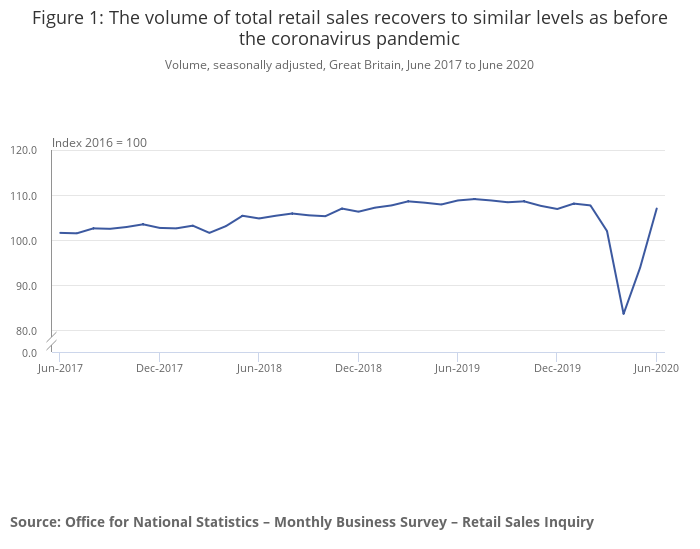Retail sales return to pre-pandemic levels with 13.9% surge in June

Retail sales rebounded strongly in June as non-essential shops reopened, taking sales back to pre-pandemic levels.
New figures published by the Office for National Statistics (ONS) on Friday showed retail sales rose by 13.9% in June, far exceeding economists’ expectations of an 8% month-on-month rise.
June marked the second strong month of retail sales growth, following record falls in March and April. Sales are now more or less where they were prior to the onset of the COVID-19 pandemic.

Retail sales were down just 1.9% compared to June 2019 — much better than economists had forecast.
The recovery came as non-essential shops reopened from the middle of June and lockdown restrictions began to ease.
The ONS said not all shops were benefitting equally, however.
Winners include grocers, DIY stores, and online retailers, which continue to account for almost a third of total sales. Online retail was just 20% of the market prior to the pandemic but average weekly sales online have jumped by almost £1bn ($1.26bn) since February.
Non-food and fuel sales still lag behind. Fuel sales are down by 30% compared to February, while clothing and footwear sales are 34% lower.
READ MORE: COVID-19 lockdown improves households' financial confidence and boosts savings, survey finds
Economists and analysts greeted the ONS data with caution.
Samuel Tombs, chief UK economist at Pantheon Macroeconomics, said retail sales were “unrepresentative of overall spending” and benefited from the continued closure of restaurants, pubs, cinemas, and other forms of entertainment and leisure.
“Retail sales usually account for only 31% of households’ overall expenditure, and they have benefited from households reallocating funds usually reserved for services, which remained largely unavailable in June,” he wrote.
Tombs said household income would still remain under pressure this year and said the retail sales data did not support the idea of a quick bounce back for the whole UK economy.
James Smith, a developed market economist at Dutch bank ING, agreed that the retail sales rebound “doesn't necessarily imply that we're heading for a 'V-shape' recovery”.
“Even though retail sales figures are encouraging, we shouldn’t overstate them,” Smith wrote in a note to clients on Friday. “Whether this translates into a sustained pick-up in sales will depend on how bad the rise in unemployment is over the coming weeks and months.”
Matthew Woodcock, director of logistics software company LLamasoft, said: “Although today’s news is positive, retailers should keep the champagne on ice. The reopening of shops has released a lot of pent-up demand, but whether this will be sustained is yet to be seen.”
READ MORE: Coronavirus: Mask rule in shops 'flashpoint for abuse' of staff
A separate survey released on Friday suggested the sales surge may be short-lived. Market research firm GfK found consumer confidence at -27. That was up from near record lows recorded earlier in the pandemic but still well below pre-pandemic levels.
“There’s been little to boost the public’s mood as the cost of the pandemic to the UK’s economy is becoming apparent,” said Joe Staton, GfK’s Client Strategy Director.
Staton said waves of job losses and the looming end to the government’s job retention scheme meant consumers were saving rather than spending in case they fall on hard times.
“The way we perceive our ’future wallets’ is key as it’s the one area over which we have day-to-day control and is a good indicator of our personal financial outlook for the year to come,” Staton said.

